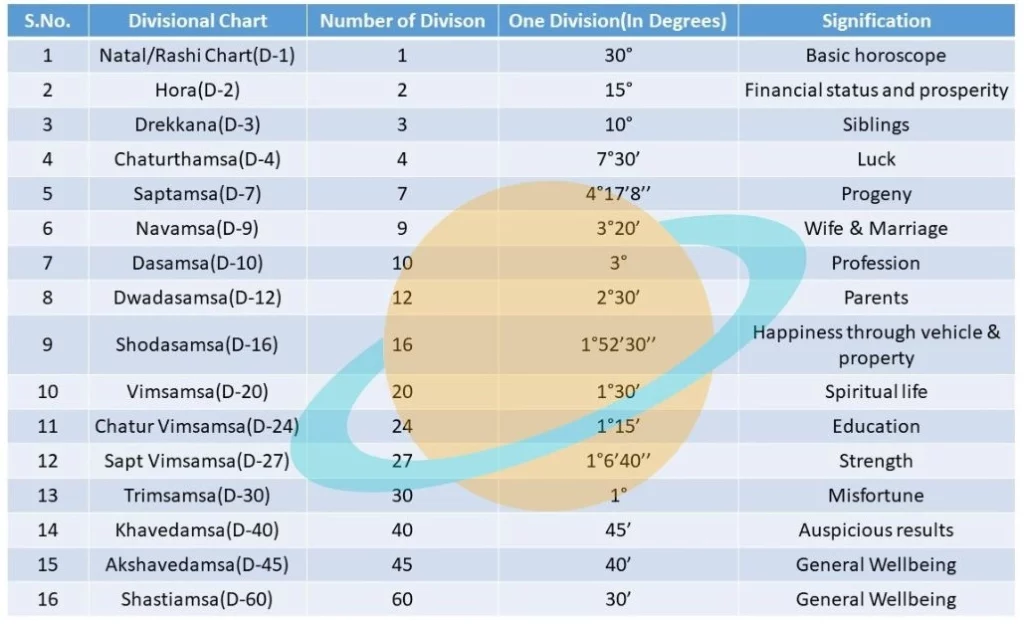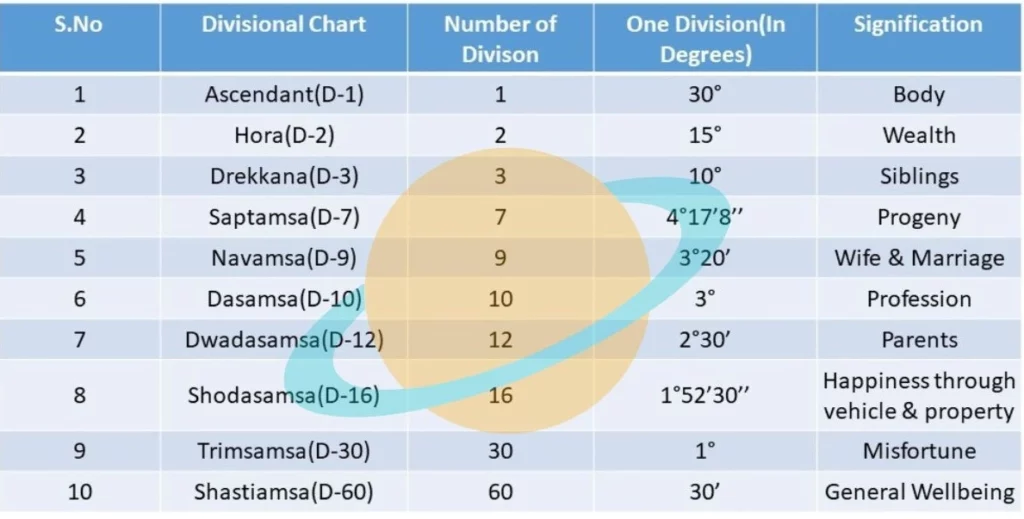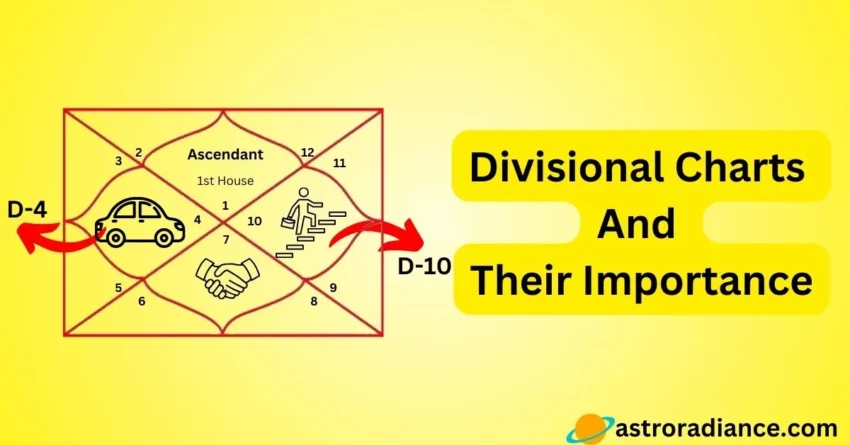We know that we can study various aspects of life through various houses of the birth chart. For example, if we have to think about the personality of a person, then we will consider the position of that person’s first house or ascendant and its ascendant, for wealth and family second house, and so on. But if we want to know in more detail about any house we consider Divisional Charts.
12 Houses And Their Significance
In astrology, different areas of life are associated with different houses in the birth chart are
- The first house (ascendant) tells us about a person’s personality.
- The second house is related to money and family.
- The third house is about courage and siblings.
- The fourth house represents the mother, home, and vehicles.
- The fifth house is linked to children and intelligence.
- The sixth house is connected to health, enemies, and debts.
- The seventh house is about marriage and partnerships.
- The eighth house is about longevity.
- The ninth house relates to the father and luck.
- The tenth house is about career and public image.
- The eleventh house represents income and gains.
- The twelfth house is about expenses and losses.
These houses and their rulerships help astrologers understand different aspects of a person’s life based on the placement of planets within them.
We can know many things about a person’s life from the natal chart(birth chart), but if we want to think more deeply about any aspect of life, then we should consider the divisional charts.
If we want to understand someone’s career, we should consider the D-10 chart along with the birth chart. D-10 chart, also known as the Dasamsa chart, is specifically used to analyze a person’s career, profession, and achievements. It is considered an important supplement to the birth chart (natal chart) for understanding career-related matters in more detail. By examining both the birth chart and the D-10 chart together, we can gain deeper insights into a person’s professional life, including potential career paths, success in various fields, and periods of career growth or challenges.
Divisional Charts(Varga Kundali)
If we want to study something with depth and subtlety, then we should look at the divisional charts. Just as different houses reflect different aspects of life, in the same way, different Varga Kundalis also tell about a particular aspect of life in more detail. For example, a life partner is considered through Navamsh Kundli.
In the Navamsa Chart, each zodiac sign is divided into nine parts. Life partner and destiny are considered through the Navamsa Kundli. Similarly, the zodiac sign is further divided into fractions such as Hora (two parts), Dreshkana (three parts), Chaturthamsa (four parts), Saptamsa (seven parts), Dashamsa (ten parts), Dwadashamsa (twelve parts), Shodashamsa (sixteen parts), and Shashtiamsa (sixty parts). These divisions are collectively referred to as the horoscope.
Types of Divisional Charts
Sage Parashara has detailed various divisional charts in the Brihat Parashara Hora Shastra. These include Shadvarga, Saptavarga, Dashavarga, and Shodashvarga, which are the four types of divisions.
Shodash Varga
It has been explained in BPHS that there are sixteen divisional charts, known as Shodashvarga, which are as follows:
- Birth/Rashi Kundli,
- Hora,
- Dreshkana,
- Chaturvansh,
- Saptamansh,
- Navamsh,
- Dashmansh,
- Dwadsamsh,
- Shodashansh,
- Trishansh,
- Chaturvishansh,
- Saptavishansh,
- Trinshadamsh,
- Khavedamsh/Chatvaryansh,
- Akshvedamsh/Panch Chatvaryansh,
- Shashtiansh.

Shadvarga and Saptvarga
When only six divisions, namely Rashi, Hora, Dreshkana, Navamsha, Dvadasaansha, and Trisaansha, are considered, it is referred to as Shadvarga. Similarly, when Saptamansha is included along with the six divisions of Shadvarga, it becomes known as Saptavarga.


Dashvarga
In Dashavarga, Rashi, Hora, Dreshkana, Trishansha, Saptamansha, Navamsha, Dashmansha, Dwadshansha, Shodshansha, and Shastyansha are considered.

Importance of Varg Kundali
If a planet appears to be in a favorable position in the birth chart but is situated unfavorably in the divisional charts, its beneficial effects may not manifest as strongly as anticipated. Conversely, if a planet is poorly placed in the birth chart but occupies a favorable position in divisional charts like Navamsha, it tends to mitigate the negative impacts and may not yield unfavorable results.
According to Brihat Parashara Hora Shastra, a planet situated in its exalted sign, the Mooltrikona sign, or its own sign, is considered auspicious. Conversely, if a planet is in a state of weakness such as being combust, defeated in war, debilitated, or in a weakened state due to planetary aspects, it is considered inauspicious.
Yogas formed by auspicious Division
If any planet in Shadvarga is auspicious in two divisions then it is called Kimshuka, Vyanjana in three, Chamara in four, Chatra in five and if it is auspicious in six class then it is called Kundala. The remaining six classes in Saptavarga are similar to Shadvarga. If there is auspiciousness in seven divisions, it is called a Mukuta.
In Dashvarga, the combination of 2 good Vargas leads to Parijata, 3 to Uttama, 4 to Gopura, 5 to Simhasana, 6 to Paravata, 7 to Devloka, 8 to Brahmaloka, 9 to Shakravahana, 10 to Sridhama Yoga.
In Shodashvarga, due to the combination of 2 good Vargas, Bhedaka, 3 to Kusuma, 4 to Nagpushpa, 5 to Kanduka, 6 to Kerala, 7 to Kalpavriksha, 8 to Chandanavana, 9 to Purnachandra, 10 to Uchchaishrava, 11 to Dhanvantari, 12 to Suryakanta, 13 to Vidruma, 14 to Simhasana, 15 to Goloka, and16 to Shrivallabha Yoga.
Vargottama Planet
When a planet is in the same zodiac sign in the birth chart and Navamsha chart, it is called Vargottama. According to the scriptures, Vargottama planet gives very good results. For example, if a planet is in Aries in the birth chart and is also in Aries in the Navamsha, then it will be called Vargottama.
Some classical texts consider a planet in its Vargotamma divisional chart to be even better than an exalted planet. A Vargottama planet not only gains strength but also exerts a more profound influence on the individual’s life. It amplifies the qualities and significations associated with that planet, thereby enhancing its impact.
For example, if the Sun occupies the same sign in both the D1 (birth chart) and D9 (Navamsa chart), it has the potential to confer significant power, confidence, authority, and a prominent professional position.



